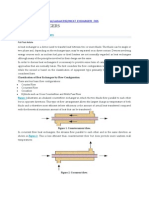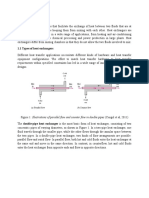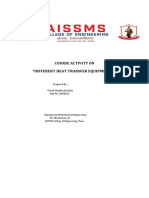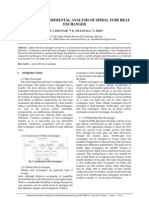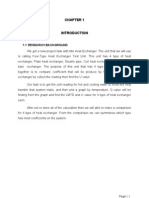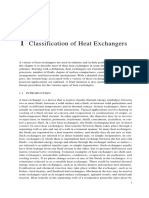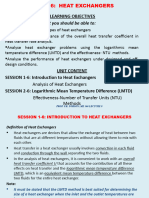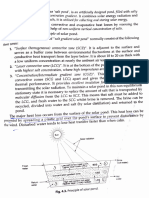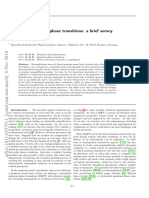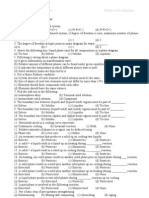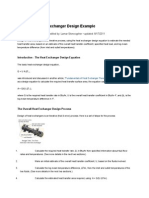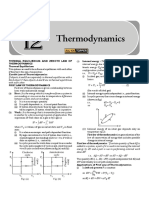Heat Exchanger
Heat Exchanger
Uploaded by
izadbakhsh2010Copyright:
Available Formats
Heat Exchanger
Heat Exchanger
Uploaded by
izadbakhsh2010Original Title
Copyright
Available Formats
Share this document
Did you find this document useful?
Is this content inappropriate?
Copyright:
Available Formats
Heat Exchanger
Heat Exchanger
Uploaded by
izadbakhsh2010Copyright:
Available Formats
HEAT EXCHANGERS
• © 2005 Begell House Inc.
Printed 5/31/2006 from IP: 81.31.160.4
HEAT EXCHANGERS
R. J. Brogan
Following from: Heat transfer
Leading to: Air cooled heat exchangers; Cooling towers; Direct contact heat exchangers; Double pipe heat
exchangers; Feedwater heaters; Graphite block heat exchangers; Optimization of heat exchanger design;
Plate and fin heat exchanger; Plate and frame heat exchangers; Regenerative heat exchangers; Scraped
surface heat exchangers; Shell and tube heat exchangers; Spiral heat exchangers
A heat exchanger is a device used to transfer heat between two or more fluids. The fluids can be single or two
phase and, depending on the exchanger type, may be separated or in direct contact. Devices involving energy
sources such as nuclear fuel pins or fired heaters are not normally regarded as heat exchangers although
many of the principles involved in their design are the same.
In order to discuss heat exchangers it is necessary to provide some form of categorization. There are two
approaches that are normally taken. The first considers the flow configuration within the heat exchanger, while
the second is based on the classification of equipment type primarily by construction. Both are considered
here.
Classification of Heat Exchangers by Flow Configuration
There are four basic flow configurations:
● Counter Flow
● Cocurrent Flow
● Crossflow
● Hybrids such as Cross Counterflow and Multi Pass Flow
Figure 1 illustrates an idealized counterflow exchanger in which the two fluids flow parallel to each other but in
opposite directions. This type of flow arrangement allows the largest change in temperature of both fluids and
is therefore most efficient (where efficiency is the amount of actual heat transferred compared with the
theoretical maximum amount of heat that can be transferred).
file:///A|/direct%20ciontact/HEAT%20EXCHANGERS.htm (1 of 10)6/1/2006 8:22:36 AM
HEAT EXCHANGERS
Figure 1. Countercurrent flow.
In cocurrent flow heat exchangers, the streams flow parallel to each other and in the same direction as shown
in Figure 2, This is less efficient than countercurrent flow but does provide more uniform wall temperatures.
Figure 2. Cocurrent flow.
Crossflow heat exchangers are intermediate in efficiency between countercurrent flow and parallel flow
exchangers. In these units, the streams flow at right angles to each other as shown in Figure 3.
Figure 3. Crossflow.
In industrial heat exchangers, hybrids of the above flow types are often found. Examples of these are
combined crossflow/counterflow heat exchangers and multi pass flow heat exchangers. (See for example
Figure 4.)
file:///A|/direct%20ciontact/HEAT%20EXCHANGERS.htm (2 of 10)6/1/2006 8:22:36 AM
HEAT EXCHANGERS
Figure 4. Cross/counter flow.
Classification of Heat Exchangers by Construction
In this section heat exchangers are classified mainly by their construction, Garland (1990), (see Figure 5). The
first level of classification is to divide heat exchanger types into recuperative or regenerative. A Recuperative
Heat Exchanger has separate flow paths for each fluid and fluids flow simultaneously through the exchanger
exchanging heat across the wall separating the flow paths. A Regenerative Heat Exchanger has a single flow
path, which the hot and cold fluids alternately pass through.
Figure 5. Heat exchanger classifications.
Regenerative heat exchangers
In a regenerative heat exchanger, the flow path normally consists of a matrix, which is heated when the hot
fluid passes through it (this is known as the "hot blow"). This heat is then released to the cold fluid when this
flows through the matrix (the "cold blow"). Regenerative Heat Exchangers are sometimes known as Capacitive
Heat Exchangers. A good overview of regenerators is provided by Walker (1982).
Regenerators are mainly used in gas/gas heat recovery applications in power stations and other energy
intensive industries. The two main types of regenerator are Static and Dynamic. Both types of regenerator are
transient in operation and unless great care is taken in their design there is normally cross contamination of the
hot and cold streams. However, the use of regenerators is likely to increase in the future as attempts are made
to improve energy efficiency and recover more low grade heat. However, because regenerative heat
file:///A|/direct%20ciontact/HEAT%20EXCHANGERS.htm (3 of 10)6/1/2006 8:22:36 AM
HEAT EXCHANGERS
exchangers tend to be used for specialist applications recuperative heat exchangers are more common.
Recuperative heat exchangers
There are many types of recuperative exchangers, which can broadly be grouped into indirect contact, direct
contact and specials. Indirect contact heat exchangers keep the fluids exchanging heat separate by the use of
tubes or plates etc.. Direct contact exchangers do not separate the fluids exchanging heat and in fact rely on
the fluids being in close contact.
Heat Exchanger Types
This section briefly describes some of the more common types of heat exchanger and is arranged according to
the classification given in Figure 5.
Indirect heat exchangers
In this type, the steams are separated by a wall, usually metal. Examples of these are tubular exchangers, see
Figure 6, and plate exchangers, see Figure 7.
Tubular heat exchangers are very popular due to the flexibility the designer has to allow for a wide range of
pressures and temperatures. Tubular heat exchangers can be subdivided into a number of categories, of
which the shell and tube exchanger is the most common.
A Shell and Tube Exchanger consists of a number of tubes mounted inside a cylindrical shell. Figure 8
illustrates a typical unit that may be found in a petrochemical plant. Two fluids can exchange heat, one fluid
flows over the outside of the tubes while the second fluid flows through the tubes. The fluids can be single or
two phase and can flow in a parallel or a cross/counter flow arrangement. The shell and tube exchanger
consists of four major parts:
● Front end–this is where the fluid enters the tubeside of the exchanger.
● Rear end–this is where the tubeside fluid leaves the exchanger or where it is returned to the front
header in exchangers with multiple tubeside passes.
● Tube bundle–this comprises of the tubes, tube sheets, baffles and tie rods etc. to hold the bundle
together.
● Shell—this contains the tube bundle.
The popularity of shell and tube exchangers has resulted in a standard being developed for their designation
and use. This is the Tubular Exchanger Manufactures Association (TEMA) Standard. In general shell and
tube exchangers are made of metal but for specialist applications (e.g., involving strong acids of
pharmaceuticals) other materials such as graphite, plastic and glass may be used. It is also normal for the
tubes to be straight but in some cryogenic applications helical or Hampson coils are used. A simple form of the
shell and tube exchanger is the Double Pipe Exchanger. This exchanger consists of a one or more tubes
contained within a larger pipe. In its most complex form there is little difference between a multi tube double
file:///A|/direct%20ciontact/HEAT%20EXCHANGERS.htm (4 of 10)6/1/2006 8:22:36 AM
HEAT EXCHANGERS
pipe and a shell and tube exchanger. However, double pipe exchangers tend to be modular in construction
and so several units can be bolted together to achieve the required duty. The book by E.A.D. Saunders
[Saunders (1988)] provides a good overview of tubular exchangers.
Other types of tubular exchanger include:
● Furnaces—the process fluid passes through the furnace in straight or helically wound tubes and the
heating is either by burners or electric heaters.
● Tubes in plate—these are mainly found in heat recovery and air conditioning applications. The tubes
are normally mounted in some form of duct and the plates act as supports and provide extra surface
area in the form of fins.
● Electrically heated–in this case the fluid normally flows over the outside of electrically heated tubes,
(see Joule Heating).
● Air Cooled Heat Exchangers consist of bundle of tubes, a fan system and supporting structure. The
tubes can have various type of fins in order to provide additional surface area on the air side. Air is
either sucked up through the tubes by a fan mounted above the bundle (induced draught) or blown
through the tubes by a fan mounted under the bundle (forced draught). They tend to be used in
locations where there are problems in obtaining an adequate supply of cooling water.
● Heat Pipes, Agitated Vessels and Graphite Block Exchangers can be regarded as tubular or could
be placed under Recuperative "Specials". A heat pipe consists of a pipe, a wick material and a working
fluid. The working fluid absorbs heat, evaporates and passes to the other end of the heat pipe were it
condenses and releases heat. The fluid then returns by capillary action to the hot end of the heat pipe
to re-evaporate. Agitated vessels are mainly used to heat viscous fluids. They consist of a vessel with
tubes on the inside and an agitator such as a propeller or a helical ribbon impeller. The tubes carry the
hot fluid and the agitator is introduced to ensure uniform heating of the cold fluid. Carbon block
exchangers are normally used when corrosive fluids need to be heated or cooled. They consist of solid
blocks of carbon which have holes drilled in them for the fluids to pass through. The blocks are then
bolted together with headers to form the heat exchanger.
Plate heat exchangers separate the fluids exchanging heat by the means of plates. These normally have
enhanced surfaces such as fins or embossing and are either bolted together, brazed or welded. Plate heat
exchangers are mainly found in the cryogenic and food processing industries. However, because of their high
surface area to volume ratio, low inventory of fluids and their ability to handle more than two steams, they are
also starting to be used in the chemical industry.
Plate and Frame Heat Exchangers consist of two rectangular end members which hold together a number of
embossed rectangular plates with holes on the corner for the fluids to pass through. Each of the plates is
separated by a gasket which seals the plates and arranges the flow of fluids between the plates, see Figure 9.
This type of exchanger is widely used in the food industry because it can easily be taken apart to clean. If
leakage to the environment is a concern it is possible to weld two plate together to ensure that the fluid flowing
between the welded plates can not leak. However, as there are still some gaskets present it is still possible for
leakage to occur. Brazed plate heat exchangers avoid the possibility of leakage by brazing all the plates
together and then welding on the inlet and outlet ports.
file:///A|/direct%20ciontact/HEAT%20EXCHANGERS.htm (5 of 10)6/1/2006 8:22:36 AM
HEAT EXCHANGERS
Figure 6. Tubular exchanger classification.
Figure 7. Plate exchanger classification.
Figure 8. Shell and tube exchanger.
file:///A|/direct%20ciontact/HEAT%20EXCHANGERS.htm (6 of 10)6/1/2006 8:22:36 AM
HEAT EXCHANGERS
Figure 9. Plate and frame exchanger.
Plate Fin Exchangers consist of fins or spacers sandwiched between parallel plates. The fins can be
arranged so as to allow any combination of crossflow or parallel flow between adjacent plates. It is also
possible to pass up to 12 fluid streams through a single exchanger by careful arrangement of headers. They
are normally made of aluminum or stainless steel and brazed together. Their main use is in gas liquefaction
due to their ability to operate with close temperature approaches.
Lamella heat exchangers are similar in some respects to a shell and tube. Rectangular tubes with rounded
corners are stacked close together to form a bundle, which is placed inside a shell. One fluid passes through
the tubes while the fluid flows in parallel through the gaps between the tubes. They tend to be used in the pulp
and paper industry where larger flow passages are required.
Spiral plate exchangers are formed by winding two flat parallel plates together to form a coil. The ends are
then sealed with gaskets or are welded. They are mainly used with viscous, heavily fouling fluids or fluids
containing particles or fibres.
Direct contact
This category of heat exchanger does not use a heat transfer surface, because of this, it is often cheaper than
indirect heat exchangers. However, to use a direct contact heat exchanger with two fluids they must be
immiscible or if a single fluid is to be used it must undergo a phase change. (See Direct Contact Heat
Transfer.)
The most easily recognizable form of direct contact heat exchanger is the natural draught Cooling Tower
found at many power stations. These units comprise of a large approximately cylindrical shell (usually over 100
m in height) and packing at the bottom to increase surface area. The water to be cooled is sprayed onto the
packing from above while air flows in through the bottom of the packing and up through the tower by natural
buoyancy. The main problem with this and other types of direct contact cooling tower is the continuous need to
make up the cooling water supply due to evaporation.
Direct contact condensers are sometimes used instead of tubular condensers because of their low capital and
maintenance costs. There are many variations of direct contact condenser. In its simplest form a coolant is
sprayed from the top of a vessel over vapor entering at the side of the vessel. The condensate and coolant are
file:///A|/direct%20ciontact/HEAT%20EXCHANGERS.htm (7 of 10)6/1/2006 8:22:36 AM
HEAT EXCHANGERS
then collected at the bottom. The high surface area achieved by the spray ensures they are quite efficient heat
exchangers.
Steam injection is used for heating fluids in tanks or in pipelines. The steam promotes heat transfer by the
turbulence created by injection and transfers heat by condensing. Normally no attempt is made to collect the
condensate.
Direct heating is mainly used in dryers where a wet solid is dried by passing it through a hot air stream.
Another form of direct heating is Submerged Combustion. This was developed mainly for the concentration
and crystallization of corrosive solutions. The fluid is evaporated by the flame and exhaust gases being aimed
down into the fluid which is held in some form of tank.
Specials
The wet surface air cooler is similar in some respects to an air cooled heat exchanger. However, in this type of
unit water is sprayed over the tubes and a fan sucks air and the water down over the tube bundle. The whole
system is enclosed and the warm damp air is normally vented to atmosphere.
Scraped Surface Exchangers consist of a jacketed vessel which the fluid passes through and a rotating
scraper which continuously removes deposit from the inside walls of the vessel. These units are used in the
food and pharmaceutical industry in process where deposits form on the heated walls of the jacketed vessel.
Static Regenerators
Static regenerators or fixed bed regenerators have no moving parts except for valves. In this case the hot gas
passes through the matrix for a fixed time period at the end of which a reversal occurs, the hot gas is shut off
and the cold gas passes through the matrix. The main problem with this type of unit is that both the hot and
cold flow are intermittent. To overcome this and have continuous operation at least two static regenerators are
required or a rotary regenerator could be used.
Rotary regenerator
In a rotary regenerator cylindrical shaped packing rotates about the axis of a cylinder between a pair of gas
seals. Hot and cold gas flows simultaneously through ducting on either side of the gas seals and through the
rotating packing. (See Regenerative Heat Exchangers.)
Thermal Analysis
The thermal analysis of any heat exchanger involves the solution of the basic heat transfer equation.
(1)
This equation calculates the amount of heat transferred through the area dA, where Th and Tc are the
file:///A|/direct%20ciontact/HEAT%20EXCHANGERS.htm (8 of 10)6/1/2006 8:22:36 AM
HEAT EXCHANGERS
local temperatures of the hot and cold fluids, α is the local heat transfer coefficient and dA is the local
incremental area on which α is based. For a flat wall
(2)
where δw is the wall thickness and λw its thermal conductivity.
For single phase flow past the wall α for each of the streams is a function of Re and Pr. When condensing or
boiling is taking place α may also be a function of the temperature difference. Once the heat transfer
coefficient for each stream and the wall are known the overall heat transfer coefficient U is then given by
(3)
where the wall resistance rw is given by 1/αw. The total rate of heat transfer between the hot and cold fluids is
then given by
(4)
This equation is for constant temperatures and heat transfer coefficients. In most heat exchangers this is not
the case and so a different form of the equation is used
(5)
where is the total heat load, U is the mean overall heat transfer coefficient and ∆TM the mean temperature
difference. The calculation of ∆TM and the removal of the constant heat transfer coefficient assumption is
described in Mean Temperature Difference.
Calculation of U and ∆TM requires information on the exchanger type, the geometry (e.g., the size of the
passages in a plate or the diameter of a tube), flow orientation, pure countercurrent flow or crossflow, etc. The
total duty can then be calculated using an assumed value of AT and compared with the required duty.
Changes to the assumed geometry can then be made and U, ∆TM and recalculated to eventually iterate to
a solution where is equal to the required duty. However, in performing the thermal analysis a check should
also be made at each iteration that the allowable pressure drop is not exceeded. Computer programs such as
TASC from HTFS (Heat Transfer and Fluid Flow Service) perform these calculations automatically and
optimize the design.
Mechanical Considerations
All heat exchangers types have to undergo some form of mechanical design. Any exchanger that operates at
above atmospheric pressure should be designed according to the locally specified pressure vessel design
code such as ASME VIII (American Society of Mechanical Engineers) or BS 5500 (British Standard). These
codes specify the requirements for a pressure vessel, but they do not deal with any specific features of a
particular heat exchanger type. In some cases specialist standards exist for certain types of heat exchanger.
Two of these are listed below, but in general individual manufacturers define their own standards.
file:///A|/direct%20ciontact/HEAT%20EXCHANGERS.htm (9 of 10)6/1/2006 8:22:36 AM
HEAT EXCHANGERS
References
Garland, W. J. (1990) Private Communication.
Walker,G. (1982) Industrial Heat Exchangers-A Basic Guide, Hemisphere Publishing Corporation.
Rohsenow, W. M. and Hartnett, J. P. (1973) Handbook of Heat Transfer, New York: McGraw-Hill Book
Company.
Saunders, E. A. D. (1988) Heat Exchangers–Selection, Design and Construction, Longman Scientific and
Technical.
Tubular Exchanger Manufacturers, Association, (1988) (TEMA) Seventh Edition. Shell and Tube Exchangers.
American Petroleum Institute (API) 661: Air Cooled Heat Exchangers for the Petroleum Industry.
© 2005 Begell House Inc.
Printed 5/31/2006 from IP: 81.31.160.4
file:///A|/direct%20ciontact/HEAT%20EXCHANGERS.htm (10 of 10)6/1/2006 8:22:36 AM
You might also like
- Assignment 2Document28 pagesAssignment 2ahsan aliNo ratings yet
- Air Cooled Heat Exchanger Handbook: Fundamentals, Calculations, Design and Q&AFrom EverandAir Cooled Heat Exchanger Handbook: Fundamentals, Calculations, Design and Q&ANo ratings yet
- Double Pipe Heat ExchangersDocument36 pagesDouble Pipe Heat Exchangersshreyasnil50% (2)
- Mechanical Design of Shell and Tube Heat ExchangerDocument69 pagesMechanical Design of Shell and Tube Heat ExchangerFazil HassanNo ratings yet
- Test of A Tubular CondenserDocument9 pagesTest of A Tubular CondenserDevin Bea0% (1)
- Heat Exchanger.Document10 pagesHeat Exchanger.RajarajeswariNo ratings yet
- ProjectDocument24 pagesProjectSantosh Kumar Hotta100% (1)
- A Check Valve in The Chiller BypassDocument5 pagesA Check Valve in The Chiller BypassGaye KanalNo ratings yet
- Heat ExchangersDocument8 pagesHeat Exchangerskats2404No ratings yet
- Heat Exchanger Important DocumentDocument126 pagesHeat Exchanger Important DocumentUsamaAli100% (1)
- Experiment No. 8 Heat ExchangerDocument26 pagesExperiment No. 8 Heat ExchangerAli Requiso Mahmud100% (1)
- Department of Mechanical Engineering Indian Institute of Engineering Science and Technology, ShibpurDocument15 pagesDepartment of Mechanical Engineering Indian Institute of Engineering Science and Technology, ShibpurSuraj Kumar0% (1)
- Engineering Drawing Project Report: Heat ExchangerDocument10 pagesEngineering Drawing Project Report: Heat ExchangerDhanis ParamaguruNo ratings yet
- Designn of Heat ExchangerDocument53 pagesDesignn of Heat ExchangerBalu BalireddiNo ratings yet
- Introduction To Heat ExchangerDocument15 pagesIntroduction To Heat ExchangernsfvhsfNo ratings yet
- Shell and Tube Heat Exchanger: Wall ThicknessDocument10 pagesShell and Tube Heat Exchanger: Wall ThicknessZeke KazamiNo ratings yet
- Conceptual Diagram of A Plate and Frame Heat Exchanger02Document9 pagesConceptual Diagram of A Plate and Frame Heat Exchanger02sai thesisNo ratings yet
- Heat ExchangerDocument5 pagesHeat ExchangerMurtaza NaeemNo ratings yet
- Parallel - Counter Flow Heat ExchangerDocument12 pagesParallel - Counter Flow Heat Exchangerjr gajelesNo ratings yet
- Types of Heat Exchangers - Classification of Heat ExchangersDocument3 pagesTypes of Heat Exchangers - Classification of Heat ExchangersMuhammet Ahmet SarıkayaNo ratings yet
- Heat Exchanger: Flow ArrangementDocument5 pagesHeat Exchanger: Flow ArrangementdileepNo ratings yet
- Types of Heat ExchangersDocument14 pagesTypes of Heat ExchangersMuhammadFahadIjazNo ratings yet
- Heat Exchangers Simple OverviewDocument20 pagesHeat Exchangers Simple OverviewAdhrith JhaNo ratings yet
- Introduction Heat ExchangerDocument11 pagesIntroduction Heat ExchangerLorna AhlaamiNo ratings yet
- Shell and Tube Heat ExchangerDocument30 pagesShell and Tube Heat ExchangerMurphy MofeNo ratings yet
- Heat Transfer & ExchangersDocument19 pagesHeat Transfer & ExchangersSanadNo ratings yet
- Wa000777Document12 pagesWa000777RushikeshNo ratings yet
- Shell and Tube Heat Exchanger: Research TitleDocument10 pagesShell and Tube Heat Exchanger: Research TitleDimas SatriaNo ratings yet
- Chemical Engineering: Govt - Polytechnic Mankenda (Agra)Document47 pagesChemical Engineering: Govt - Polytechnic Mankenda (Agra)Shekhar YaduvanshiNo ratings yet
- Design and Experimental Analysis of Spiral Tube Heat ExchangerDocument6 pagesDesign and Experimental Analysis of Spiral Tube Heat ExchangergpcshfNo ratings yet
- 1.1 Research Background: Heat Exchanger FCB40302Document68 pages1.1 Research Background: Heat Exchanger FCB40302ImranMustaffaNo ratings yet
- Double Pipe Heat ExchangersDocument27 pagesDouble Pipe Heat ExchangersDURGA KASTURINo ratings yet
- HMT ReportDocument12 pagesHMT ReportRushikeshNo ratings yet
- Heat and Heat ExchangerDocument20 pagesHeat and Heat ExchangerDamisha DamishaNo ratings yet
- Heat Exchangers SeminarDocument15 pagesHeat Exchangers SeminarShivang Gupta100% (1)
- Heat Exchanger and Its Classification: Dr. Liaquat Ali KhanDocument34 pagesHeat Exchanger and Its Classification: Dr. Liaquat Ali KhanKhalil AhmadNo ratings yet
- Shell and Tube Heat ExchangerDocument4 pagesShell and Tube Heat Exchangerru4angelNo ratings yet
- 1-Classification of Heat Exchangers & Selection CriteriaDocument56 pages1-Classification of Heat Exchangers & Selection CriteriaShahid_Rao786100% (1)
- Heat ExchangerDocument10 pagesHeat Exchangertrisha.2205No ratings yet
- Shell and Tube Heat Exchanger - WikipediaDocument5 pagesShell and Tube Heat Exchanger - Wikipediabinok19No ratings yet
- Heat Exchangers V1 16-10-2019Document72 pagesHeat Exchangers V1 16-10-2019Bal krishna srivastava100% (1)
- Efficient Industrial Heat Exchangers - Seminar ReportDocument67 pagesEfficient Industrial Heat Exchangers - Seminar ReportdaemonohNo ratings yet
- Part.a.classification of Heat ExchangersDocument11 pagesPart.a.classification of Heat ExchangersAhmed GadNo ratings yet
- Heat ExchangerDocument14 pagesHeat ExchangerM Y78uNo ratings yet
- Heat Exchanger CFDDocument83 pagesHeat Exchanger CFDganeshNo ratings yet
- Heat ExchangerDocument58 pagesHeat ExchangercanyourunNo ratings yet
- Fundamentals - Heat ExchangersDocument20 pagesFundamentals - Heat ExchangersHeather KramerNo ratings yet
- Klasifikasi Heat ExchangerDocument77 pagesKlasifikasi Heat ExchangerGeovany FakhriNo ratings yet
- Heat Transfer EquipmentDocument46 pagesHeat Transfer EquipmentJoy PalitNo ratings yet
- AME 365 Heat Transfer & Combustion (UNIT 5)Document73 pagesAME 365 Heat Transfer & Combustion (UNIT 5)somenewguyonthewebNo ratings yet
- Clasificacion de IntercambiadoresDocument73 pagesClasificacion de IntercambiadoresAviNo ratings yet
- Heat ExchangerDocument9 pagesHeat ExchangerChrissa Villaflores GanitNo ratings yet
- Mechanics of the Household: A Course of Study Devoted to Domestic Machinery and Household Mechanical AppliancesFrom EverandMechanics of the Household: A Course of Study Devoted to Domestic Machinery and Household Mechanical AppliancesNo ratings yet
- Thermodynamic analysis of geothermal heat pumps for civil air-conditioningFrom EverandThermodynamic analysis of geothermal heat pumps for civil air-conditioningRating: 5 out of 5 stars5/5 (2)
- Thermal Modelling of Power Transformers Using Computational Fluid DynamicsFrom EverandThermal Modelling of Power Transformers Using Computational Fluid DynamicsNo ratings yet
- Geothermal Energy: Sustainable Heating and Cooling Using the GroundFrom EverandGeothermal Energy: Sustainable Heating and Cooling Using the GroundNo ratings yet
- How it Works: Dealing in simple language with steam, electricity, light, heat, sound, hydraulics, optics, etc., and with their applications to apparatus in common useFrom EverandHow it Works: Dealing in simple language with steam, electricity, light, heat, sound, hydraulics, optics, etc., and with their applications to apparatus in common useNo ratings yet
- Diagrama de Moolier R404ADocument1 pageDiagrama de Moolier R404AJeferson Nobre0% (1)
- Btech Thermodynamics - 2022 - 1Document3 pagesBtech Thermodynamics - 2022 - 1Shailesh Singh SuryavanshiNo ratings yet
- L3-Ch15 - Thermal Energy (Lesson 1)Document35 pagesL3-Ch15 - Thermal Energy (Lesson 1)Jamal RamadanNo ratings yet
- Manual Técnico MVD VR4 3tubos CL23115 A 119 CL23120 A 256 en 03 15Document163 pagesManual Técnico MVD VR4 3tubos CL23115 A 119 CL23120 A 256 en 03 15baljak1No ratings yet
- Quiz HMT Question PaperDocument2 pagesQuiz HMT Question Papersutha_me20098282No ratings yet
- Wa0004.Document3 pagesWa0004.aapkistory2021No ratings yet
- Freesteam Steam Tables - IAPWS-If97 Industrial Formulation - Jan 2010Document15 pagesFreesteam Steam Tables - IAPWS-If97 Industrial Formulation - Jan 2010EcisgroupNo ratings yet
- Dynamical Quantum Phase Transitions: A Brief SurveyDocument9 pagesDynamical Quantum Phase Transitions: A Brief SurveySANDIPAN BHATTACHERJEENo ratings yet
- Phet Lab - Solids, Liquids, Gases: Before You BeginDocument3 pagesPhet Lab - Solids, Liquids, Gases: Before You BeginadrianaNo ratings yet
- Interview Questions 1 TCSDocument3 pagesInterview Questions 1 TCSSrinivas TumpalaNo ratings yet
- MCQ Phase DiagramsDocument3 pagesMCQ Phase DiagramsPrince AbhishekNo ratings yet
- Heat Transfer Course Information SheetDocument10 pagesHeat Transfer Course Information SheetMech DeptNo ratings yet
- Conduction Convection or Radiation WorksheetDocument3 pagesConduction Convection or Radiation WorksheetKIM ANN OPENA VILLAROSA100% (1)
- Write Answers To All NCERT Intext Solved & Unsolved Problems. 2. Write Answers To All NCERT Questions in ExercisesDocument3 pagesWrite Answers To All NCERT Intext Solved & Unsolved Problems. 2. Write Answers To All NCERT Questions in ExercisesJagriti DaryaniNo ratings yet
- EMICON Product Overview ENGDocument20 pagesEMICON Product Overview ENGanish SamsonNo ratings yet
- M.SC (Chemistry)Document38 pagesM.SC (Chemistry)Khitish MohapatraNo ratings yet
- Thermochem Notepack 2020 Lam (Includes DIPQQ)Document49 pagesThermochem Notepack 2020 Lam (Includes DIPQQ)Rand AhmadNo ratings yet
- Manufacturing and Testing of A Gamma Type Stirling EngineDocument10 pagesManufacturing and Testing of A Gamma Type Stirling EngineFlorin FloNo ratings yet
- Density of Water TablesDocument1 pageDensity of Water TablesHaha ZazaNo ratings yet
- Specification Sheet For Aerofoam XlpeDocument3 pagesSpecification Sheet For Aerofoam XlpeElsabaa Mahmoud100% (1)
- Celculation of Static Press',, Re Gradients Iu Gas Wellis: Gas Wp.L1SDocument14 pagesCelculation of Static Press',, Re Gradients Iu Gas Wellis: Gas Wp.L1SFernando Ledesma SolaecheNo ratings yet
- Preliminary Heat Exchanger Design ExampleDocument4 pagesPreliminary Heat Exchanger Design ExamplejokishNo ratings yet
- Chapter - 12 ThermodynamicsDocument23 pagesChapter - 12 ThermodynamicsTilahun ArfichoNo ratings yet
- NF For Heat TransferDocument7 pagesNF For Heat TransferMohd Rashid SiddiquiNo ratings yet
- Solution Manual 1.45-1.46 KernDocument2 pagesSolution Manual 1.45-1.46 KernJonesHutaurukNo ratings yet
- Department of Chemical Engineering, NITK Tutorial-VIIDocument2 pagesDepartment of Chemical Engineering, NITK Tutorial-VIINandita Chouhan0% (1)
- 35 Series Shell & Tube Heat ExchangersDocument3 pages35 Series Shell & Tube Heat Exchangersrusheekesh3497No ratings yet
- Fe-C Phase Diagram Lecture 33Document15 pagesFe-C Phase Diagram Lecture 33Manish Gupta100% (1)
- Question Bank Calorimetry: 1. Define The Term HeatDocument32 pagesQuestion Bank Calorimetry: 1. Define The Term HeatTajiriMollelNo ratings yet










